Moniek Bloks's Blog, page 13
June 5, 2025
Princess Dagmar’s Floral Tiara
Princess Dagmar’s Floral Tiara is a great piece in the collection of the Danish royal family.
The provenance of the tiara is unclear, but it was first worn by Princess Dagmar of Denmark, who was the daughter of King Frederick VIII. It was a much-loved piece, and she wore it until shortly before her death.
Dagmar was married to Jørgen Castenskjold, and even though they had five children together, Dagmar left the tiara to her nephew, King Frederick IX. King Frederick gave the tiara to his daughter, the future Queen Margrethe II. As Dagmar’s husband and children were commoners, they probably had little use for a beautiful tiara.
Embed from Getty ImagesQueen Margrethe later loaned the tiara to her daughter-in-law, Princess Marie who wore it at her wedding. She has worn it often since so it’s likely to be a permanent loan from Queen Margrethe.
The post Princess Dagmar’s Floral Tiara appeared first on History of Royal Women.
Marie Antoinette’s pink diamond goes up for auction
A rare 10.38-carat purple-pink diamond, believed to have been owned by Marie Antoinette, Queen of France, is going up for auction soon.
The kite-shaped diamond, known as the Marie-Thérèse Pink Diamond, is estimated to go between $3,000,000 and $5,000,000.
According to lore, Marie Antoinette entrusted her jewels to her coiffeur on the eve of the failed escape from Paris in 1791. They never made it back to her, but the diamond was eventually passed to her only surviving child, Marie Thérèse, Duchess of Angoulême.
A few generations later, the next owner was identified as Maria Theresa of Austria-Este, Queen of Bavaria. She referred to it as “a pink solitaire diamond from Aunt Chambord.”
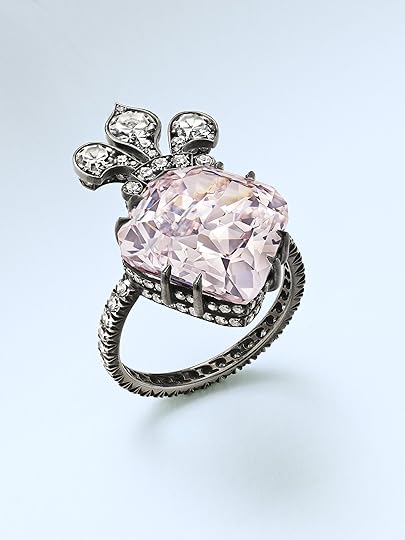
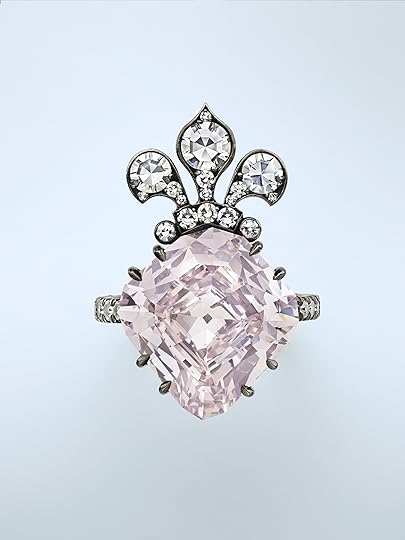

It was last at auction in 1996 when it was offered by a member of a European royal family. It has remained out of the public eye for 30 years.
It has now been set into a ring by the Parisian jeweller Joel Arthur Rosenthal (JAR).
The ring will go up for auction as part of the Magnificent Jewels auction by Christie’s, taking place on 17 June at Rockefeller Center in New York City.
The post Marie Antoinette’s pink diamond goes up for auction appeared first on History of Royal Women.
June 4, 2025
The four sisters who married the same King
King Jigme Singye Wangchuck is the fourth Druk Gyalpo (Dragon King) of Bhutan, and he reigned from 1972 until his abdication in 2006.
On 31 October 1988, he married four sisters in a public ceremony. They had married privately in 1979.
The New York Times reported the words of the Foreign Minister, who said, “Private wedding ceremonies are quite common among the Bhutanese. But a private wedding is not good enough for a King. Pressure had been building up for a proper public ceremony to be attended by all the senior members of our ecclesiastical orders.”1
By the time of the public wedding, the King already had eight children with his four brides. The official wedding was followed by a proclamation naming his eight-year-old son by Tshering Yandon as the Crown Prince.
A government official named Tsering said, “Marrying sisters is a long-standing and ‘popular’ custom among all sections of Bhutanese men. The King and his wives live in separate residences in the capital of Thimpu.2
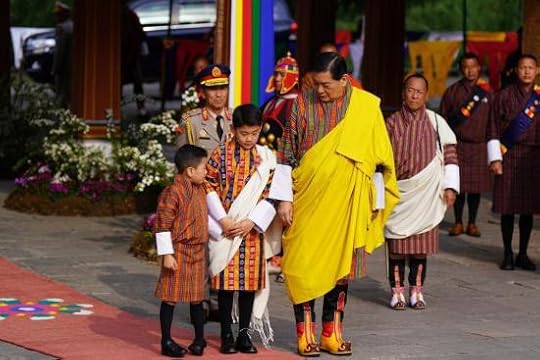 The Fourth Druk Gyalpo with Gyalsey Jigme Namgyel and Gyalsey Ugyen Wangchuck (Photo: Royal Court of Bhutan)
The Fourth Druk Gyalpo with Gyalsey Jigme Namgyel and Gyalsey Ugyen Wangchuck (Photo: Royal Court of Bhutan)Dorji Wangmo
Dorji Wangmo was born on 10 June 1955 as the daughter of Yab Dasho Ugyen Dorji (1929–2016) and Yum Thuiji Zam (born 1932). She is the first wife of the now former King. She received her education at St. Helen’s School in India. She and her husband had two children together: Princess Sonam Dechen Wangchuck (born 1981) and Prince Jigyel Ugyen Wangchuck (born 1984). She has two grandchildren.
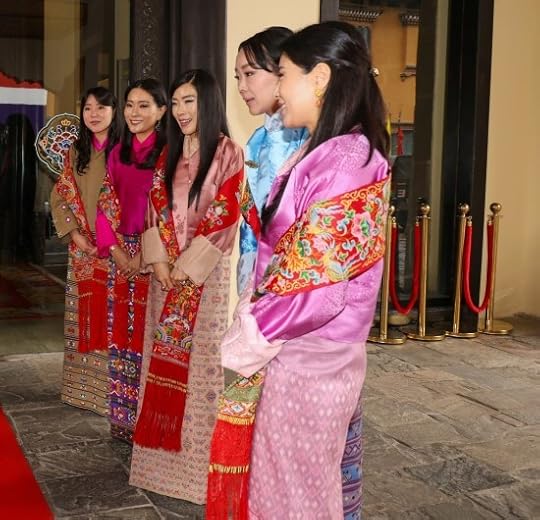 Princess Chimi Yangzom Wangchuck, Princess Sonam Dechan Wangchuck, Princess Dechen Yangzom Wangchuck, Princess Kezang Choden Wangchuck, and Princess Euphelma Choden Wangchuck (L-R) – Photo: Royal Court of Bhutan
Princess Chimi Yangzom Wangchuck, Princess Sonam Dechan Wangchuck, Princess Dechen Yangzom Wangchuck, Princess Kezang Choden Wangchuck, and Princess Euphelma Choden Wangchuck (L-R) – Photo: Royal Court of BhutanTshering Pem
Tshering Pem was born on 22 December 1957 as the daughter of Yab Dasho Ugyen Dorji (1929–2016) and Yum Thuiji Zam (born 1932). She is the second wife of the now former King. She received her education at St. Joseph’s Convent and St. Helen’s School in India. She and her husband have three children together: Princess Chimi Yangzom Wangchuck (born 1980), Princess Kesang Choden Wangchuck (born 1982) and Prince Ugyen Jigme Wangchuck (born 1994). She has five grandchildren.
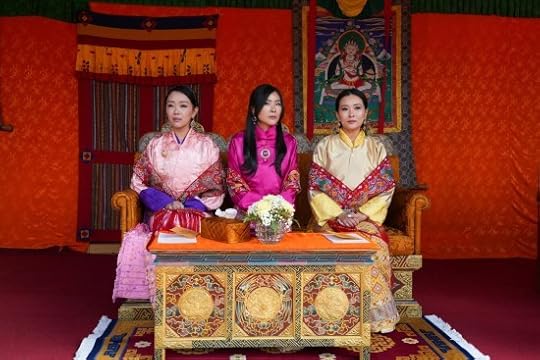 Princess Sonam Dechan Wangchuck, Princess Dechan Yangzom Wangchuck, and Princess Kesang Choden Wangchuck (Photo: Royal Court of Bhutan)
Princess Sonam Dechan Wangchuck, Princess Dechan Yangzom Wangchuck, and Princess Kesang Choden Wangchuck (Photo: Royal Court of Bhutan)Tshering Yangdon
Tshering Yangdon was born on 21 June 1959 as the daughter of Yab Dasho Ugyen Dorji (1929–2016) and Yum Thuiji Zam (born 1932). She is the third wife of the now former King. She received her education at St. Joseph’s Convent and St. Helen’s School in India. She and her husband have three children together: King Jigme Khesar Namgyel Wangchuck (born 1980), Princess Dechen Yangzom Wangchuck (born 1981) and Prince Jigme Dorji Wangchuck (born 1986). She has seven grandchildren.
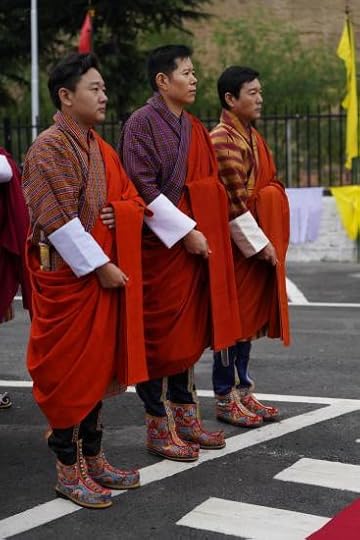 Prince Jigyel Ugyen Wangchuck, Prince Jigme Dorji Wangchuck, and Prince Ugyen Jigme Wangchuck (L-R) Photo: Royal Court of Bhutan
Prince Jigyel Ugyen Wangchuck, Prince Jigme Dorji Wangchuck, and Prince Ugyen Jigme Wangchuck (L-R) Photo: Royal Court of BhutanSangay Choden
Sangay Choden was born on 11 May 1963 as the daughter of Yab Dasho Ugyen Dorji (1929–2016) and Yum Thuiji Zam (born 1932). She is the fourth wife of the now former King. She received her education at St. Joseph’s Convent and St. Helen’s School in India. She and her husband have two children together: Prince Khamsum Singye Wangchuck (born 1985) and Princess Euphelma Choden Wangchuck (born 1993). She does not have any grandchildren (yet?).
The four women are all entitled to be called Gyalyum Kude (Queen Mother), even though Tshering Yangdon is the mother of the current King. There is no precedence among the wives, and all children are in the line of succession according to male-preference primogeniture and their age. The monarch will step down at the age of 65 if his heir has reached the age of 21. The current King is 45 years old, and the Crown Prince is 9.
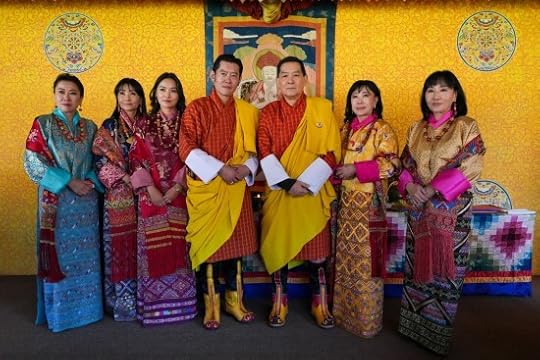 The five Queens and two Kings of Bhutan (Photo: Royal Court of Bhutan)
The five Queens and two Kings of Bhutan (Photo: Royal Court of Bhutan)Although polygamy is, obviously, allowed in Bhutan, the current King is not likely to follow his father’s example.3 He is married to Queen Jetsun Pema.
The post The four sisters who married the same King appeared first on History of Royal Women.
June 3, 2025
Book Review: The Forgotten Years of Anne Boleyn: The Habsburg & Valois Courts by Sylvia Barbara Soberton
Anne Boleyn stood out at the English court because she had spent several years in Belgium and France at the most glittering courts in Europe.
Anne would learn from the leading women at the time, Margaret of Austria, Claude of France, Louise of Savoy and Marguerite of , and she returned to England with something the English women didn’t have.
The Forgotten Years of Anne Boleyn: The Habsburg & Valois Courts by Sylvia Barbara Soberton takes the reader through Anne’s formative years. The author really manages to bring the courts of Margaret of Austria and the French to life, but information on Anne’s whereabouts is quite scarce. This means that the book sometimes feels like it’s not about Anne but about the courts alone.
Nevertheless, the information is well-researched, and I would still highly recommend this book as it fills in quite a blank spot in history.
The Forgotten Years of Anne Boleyn: The Habsburg & Valois Courts by Sylvia Barbara Soberton is available now in the UK and the US.
The post Book Review: The Forgotten Years of Anne Boleyn: The Habsburg & Valois Courts by Sylvia Barbara Soberton appeared first on History of Royal Women.
June 1, 2025
The Year of Queen Sālote Tupou III – Attending the Coronation of Queen Elizabeth II
Queen Sālote and her daughter-in-law had been in London for two weeks when it was finally coronation day on 2 June 1953.
She and Mataʻaho would not be travelling together on that day and would also not be seated together in Westminster Abbey as Mataʻaho had a seat in the stands.1 Mataʻaho left the house at 7 a.m. in a car provided by the British Council, while Queen Sālote was set to leave an hour later. She wore a long dress and a named fine-mat (possibly Lālanga-‘a-‘Ulukilupetea), a mantle, her British honours and in her hair, she wore a comb with lav’i tavaki (tropical bird feathers indicating her chiefly rank).2 Queen Sālote was driven to Buckingham Palace, where she transferred to a carriage, which she shared with the Sultan of Kelantan.
Embed from Getty ImagesEmbed from Getty ImagesEmbed from Getty ImagesQueen Sālote’s seat was in one of the constructed galleries, which looked directly down to the coronation chair. She was one of the first to arrive and watched as people arrived. Queen Sālote later wrote, “My heart was deeply touched by being a witness of such a great occasion, with its dignity and rituals. It was a religious ceremony, with all its stateliness.[…] The things that warmed me most were the moment the Archbishop announced that she was the rightful sovereign and the sound of the voice of dear young Queen making her vows.”3
She added, “When the Queen and her husband moved forward to receive the Sacrament, her crown was removed. No one who took part in that stately ceremony will ever forget the expression on the Queen’s face. An inner glow emanated from her features, and although she was tired, a new strength radiated from her. And no wonder, for she was blessed by millions and warmth came from the people to support her as she accepted the responsibilities that were laid upon her. The solemnity of the occasion touched everyone, quite apart from its glory and beauty. The coming together of nation, land, and church in supporting the Crown was clear.”4
After the ceremony, Queen Sālote was led to an annexe in the Abbey, and she was offered a light meal of tea, sandwiches and cake. During this time, it had begun to rain, and it continued to fall as Queen Sālote entered the carriage for the procession back to the palace. A policeman asked her if she wanted the hood of the carriage put up, but she “was so caught up in the warmth of the people and the feelings of grace flooding my heart from the ceremony that I could not bear to be excluded from any part of that day, good or bad. Everything on that day was a treasure. So I told the policeman to leave the hood of our carriage down. I did not think to ask the chief (the Sultan of Kelantan), and he maintained silence with good grace. I apologized to him a few days later, and he accepted my apology gladly. That day, we were both saturated with rain, but we were happy.”5
The images of a smiling Queen Sālote in her carriage in the pouring rain only added to her popularity with the British people. She arrived at her British residence around 6 p.m. and was immediately led to her room to take off her wet clothes for fear that she would fall ill, but fortunately, this did not happen. She wrote, “I was grateful to the people and the newspapers for praising me for riding in the rain, and I am honoured by their attention, but it is the same to me whether I was noticed or not. I was only happy because of the happenings of the day and the warmth that the people felt for their sovereign.”6
On her return journey, she said during an interview, “The coronation was a great occasion, and the memory of it will never die. Although I got a good soaking, but I thoroughly enjoyed it.”7
During that night, journalists carrying flowers came to inquire whether Sālote had caught a chill and by the morning, the house was surrounded. That evening, Queen Sālote attended a coronation dinner for 500 guests, and she was seated by Sir Winston Churchill and his wife. She greatly admired him and “returned home very happy.”8
Activities continued over the following days, and Queen Sālote laid a wreath at the cenotaph, she attended the Coronation Thanksgiving Service at St. Paul’s Cathedral and Trooping the Colour. She also attended several garden parties at Blenheim Palace and Lambeth Palace.
From 17 June, Mataʻaho and Sālote went on a two-week tour of Scotland, the Isle of Man and Ireland. The Queen was eventually so fatigued that Mataʻaho filled in for her at the planting of a commemoration oak tree in Windsor Great Park. The trip wasn’t quite over yet, and they then travelled to Paris and Rome, where she and Sālote had an audience with the Pope. Sālote received a gold medal from the Pope in memory of the visit, while Mataʻaho received a bronze medal.9 The last stop was Naples before the royal party boarded the Orontes on 23 July.
The trip of a lifetime was over.
The post The Year of Queen Sālote Tupou III – Attending the Coronation of Queen Elizabeth II appeared first on History of Royal Women.
May 31, 2025
Book News Week 23
Book News week 23 – 2 June – 8 June 2025

Royal Weddings: A History of Regal Matrimony (30) (Oxford People)
Hardcover – 3 June 2025 (UK)
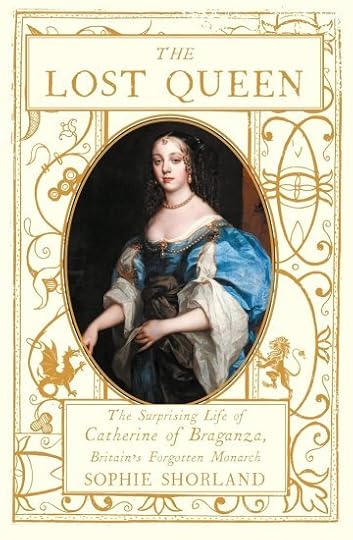
The Queen Catherine’s Court: Power and Rebellion in Restoration England
Paperback – 5 June 2025 (UK)

Regina: The Queens Who Could Have Been
Hardcover – 3 June 2025 (US)
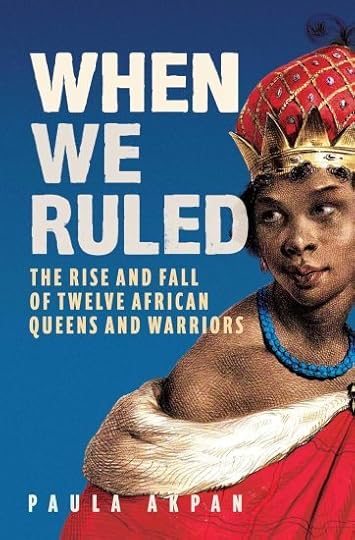
When We Ruled: The Rise and Fall of Twelve African Queens and Warriors
Hardcover – 3 June 2025 (US)
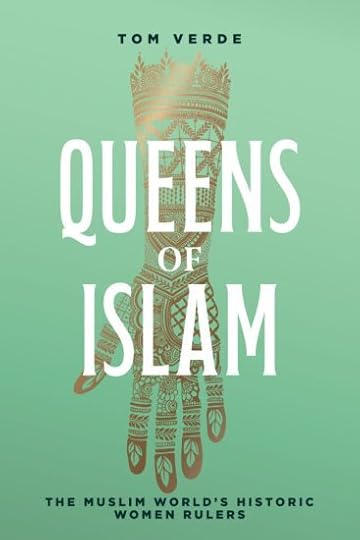
Queens of Islam: The Muslim World’s Historic Women Rulers
Paperback – 3 June 2025 (US)
The post Book News Week 23 appeared first on History of Royal Women.
The Year of Queen Sālote Tupou III – The wedding of Sālote’s parents
The future Queen Sālote’s parents, King George Tupou II and Queen Lavinia, were married on 1 June 1899 in a European-style wedding.
George wore a blue uniform laced with gold and medals. The New Zealand Herald reported, “A crimson
velvet mantle hung from his shoulders, the ends being borne by two little pages in medieval costume.”1
He also wore a crimson mantle. Lavinia wore a wedding gown of satin, a veil and orange blossoms, and she was accompanied by six bridesmaids who also wore satin. Her dress was “of the richest white Duchesse satin”, the bodice was adorned with “a handsome pearl and bead trimming, chiffon, and lace.” The six-yard-long court train of brocade was carried by her bridesmaids, and Lavinia’s slippers were “white satin braided with white and silver.”2
The ceremony was performed by Reverend Jabez Bunting Watkin.
After a choir had sung the wedding anthem, composed by the King himself, George placed a diadem on Lavinia’s head and declared her Queen of Tonga.3
After a 101-gun salute, the wedding party went to the Palace and had a wedding breakfast at the Pavilion on the lawn.
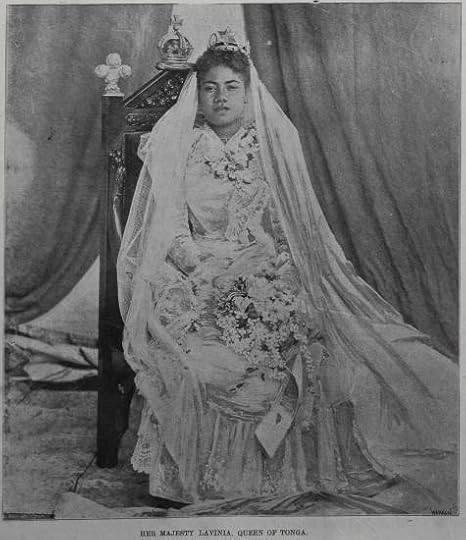 Lavinia on her wedding day (Auckland Libraries Heritage Collections AWNS-18990811-07-02)
Lavinia on her wedding day (Auckland Libraries Heritage Collections AWNS-18990811-07-02)A few days later, the Tongan wedding ceremony (tu’uvala) was held. This included exchanges of property between the chiefly families who were part of the alliance. The family of ʻOfakivavaʻu, who had been jilted by the King, was not present for either wedding ceremony, and the animosity would remain for many years to come. In the weeks after the wedding, it was rumoured that Lavinia had not left the palace since her wedding day in fear of her safety.4 Nevertheless, the new Queen brought ʻOfakivavaʻu a piece of wedding cake. The two had remained friends despite their families’s feuding.5
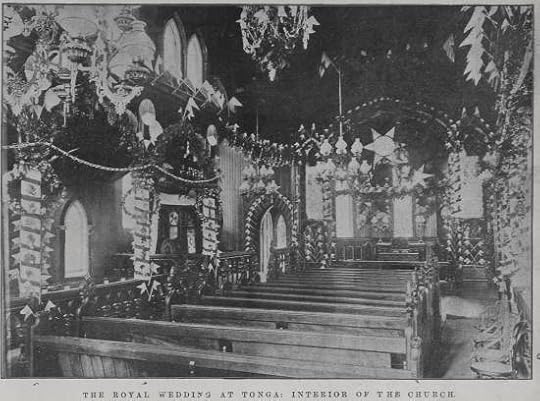 Showing the interior of His Majesty’s Church, Tonga, decorated for the marriage of King George Tupou II to Princess Lavinia. (Auckland Libraries Heritage Collections AWNS-18990630-01-02)
Showing the interior of His Majesty’s Church, Tonga, decorated for the marriage of King George Tupou II to Princess Lavinia. (Auckland Libraries Heritage Collections AWNS-18990630-01-02)Songs were a traditional form of protest. In August 1899, the press reported, ” Scurrilous songs reflecting on Her Majesty are of almost daily publication. The average Tongan is actually a poet, and his genius displays itself nowhere more acutely than in the composition of insulting songs. These are sung by almost everybody and care is especially taken that copies shall reach the Palace by secret means to the annoyance of their Majesties.”6
The post The Year of Queen Sālote Tupou III – The wedding of Sālote’s parents appeared first on History of Royal Women.
May 30, 2025
Lady Pakal of Yaxchilan – The Mayan Queen who lived to be ninety-eight
Little is known about Lady Pakal of Yaxchilan. She was the queen consort to King Yaxun B’alam III of Yaxchilan. Her son, Itzamnaaj B’ajlam III, would succeed his father as the next king of Yaxchilan. She also had a younger sister who would be her daughter-in-law named Lady Xoc. Yet, she is most renowned for living until she was ninety-eight years old.[1]
In 607 C.E., Lady Pakal was born. Her mother was Lady Xibalba.[2] Her father was Lord Aj K’an Xoc.[3] She had a younger sister named Lady Xoc (who would later be her future daughter-in-law).[4] She married King Yaxun B’ahlam III of Yaxchilan (also known as 6 Tun Jaguar (r. 631-681)).[5] Therefore, Lady Pakal became Queen of Yaxchilan.
Yaxchilan was a powerful Mayan kingdom that had a vast empire that spread north of the Usumacinta River.[6] It had a grand plaza which was where most of their activities were conducted.[7] Yaxchilan had the heaviest rainfall in the Yucatán Peninsula.[8] This contributed to the wealth of the people of Yaxchilan.[9] They also established close ties with the powerful Mayan kingdom of Calakmul.[10]
Lady Pakal bore King Yaxun B’ahlam III of Yaxchilan a son named Prince Itzamnaaj B’ajlam III (who would be King of Yaxchilan after his father’s death).[11] Prince Itzamnaaj B’ajlam III would later marry Lady Pakal’s younger sister, Lady Xoc.[12] He would also have a secondary wife named Lady Ik’ Skull (also known as Lady Eveningstar), who was from Calakmul.[13] In 681 C.E., Lady Pakal’s husband, King Yaxun B’ahlam III of Yaxchilan, died when she was seventy-four years old.[14] Her son, Itzamnaaj B’ajlam III (also known as Shield Jaguar III), became the next King of Yaxchilan (r. 681-742).
During King Itzamnaaj B’ajlam III of Yaxchilan’s long reign, he and his queen consort, Lady Xoc, conducted many religious rituals.[15] King Itzamnaaj B’ajlam III was succeeded by his son, King Yaxun Balam IV (also known as Bird Jaguar IV). Lady Pakal lived into her sixth k’atun.[16] This meant that she lived to be ninety-eight years old until she died in 705 C.E.[17] Lintels of Structure 24 lists the name of Lady Pakal.[18]
Very few facts about Lady Pakal’s long life are known. She has largely been eclipsed by her sister and daughter-in-law, Lady Xoc.[19] What is most unusual about Lady Pakal is her age.[20] Yet, as queen and queen mother, Lady Pakal must have wielded considerable influence.[21] Hopefully, with more research, more details on this forgotten Mayan queen will come to light.
Sources:
Inomata, T. (2008). “Women in Classic Maya Royal Courts”. Servants of the Dynasty: Palace Women in World History. (Walthall, A., Ed.). Oakland, CA: University of California Press. pp.45-65.
Matthews, P. (1988). The Sculpture of Yaxchilan. New Haven, CT: Yale University Press.
Sharer, R. J. & Traxler, L. P. (2006). The Ancient Maya (Sixth ed.). Stanford, CA: Stanford University Press.
Structural & Construction Conference (Volume 2). (2003). (Bontempi, F., Ed.). Volume 2. Netherlands: Taylor & Francis.
Tate, C. E. (2013). Yaxchilan: The Design of a Maya Ceremonial City. Austin, TX: University of Texas Press.
World History Encyclopedia. (2011). (Neel, C., Ed.; Andrea, A. J., Ed.). NY: Bloomsbury USA..
[1] Matthews, 1988
[2] Tate, 2013
[3] Tate, 2013
[4] Tate, 2013
[5] Sharer and Traxler, 2006
[6] Bontempi, Ed., 2003
[7] Bontempi, Ed., 2003
[8] Bontempi, Ed., 2003
[9] Bontempi, Ed., 2003
[10] Andrea and Neel, Eds., 2011
[11] Inomata, 2008
[12] Inomata, 2008
[13] Inomata, 2008
[14] Matthews, 1988
[15] Inomata, 2008
[16] Matthews, 1988
[17] Matthews, 1988
[18] Inomata, 2008
[19] Inomata, 2008
[20] Matthews, 1988
[21] Inomata, 2008
The post Lady Pakal of Yaxchilan – The Mayan Queen who lived to be ninety-eight appeared first on History of Royal Women.
May 29, 2025
The Meiji Tiara
The Meiji tiara is part of the Japanese Imperial collection and is reserved for the Empress.
The tiara was first worn by Empress Shōken, the wife of Emperor Meiji of Japan. The introduction of the tiara came after Western dress was incorporated at court in 1887.
Embed from Getty ImagesEmbed from Getty ImagesThe tiara can be worn with two toppers – a set of round diamonds and a set of diamond stars. It can also be worn without either of the toppers.
Embed from Getty ImagesEmbed from Getty ImagesThe star toppers slowly disappeared from the stage and haven’t been seen since the reign of Emperor Hirohito.
Embed from Getty ImagesThe latest wearer is Empress Masako, who wore the tiara for the first time on the day of her husband’s accession to the throne in May 2019. 1
The post The Meiji Tiara appeared first on History of Royal Women.
May 28, 2025
The Year of Queen Sālote Tupou III – Halaevalu Mataʻaho ʻAhomeʻe, Queen Sālote’s daughter-in-law
Halaevalu Mataʻaho ʻAhomeʻe was born on 29 May 1926 as the daughter of the Hon. Tevita Manu-’o-pangai ‘Ahome’e and Heuʻifanga Veikune. Her father held the posts of Governor of Vava’u and Ha’apai and Minister for Police. Her mother was a great-granddaughter of the last King of the Tuʻi Tonga Empire.
She received her education at St Joseph’s Convent School in Nuku’alofa and St Mary’s College in Auckland.
Mataʻaho was reportedly spotted by her future husband in 1945 when she was helping to serve food during the centenary celebrations, and he decided that she should be his wife. He was the eldest son of Queen Sālote Tupou III of Tonga, and he was then known as Tupoutoʻa Tungī. At the same time, his younger brother, Prince Fatafehi Tu’ipelehake, also selected a bride, Melenaite Tupoumoheofo Veikune.
Queen Sālote arranged for a double wedding so that there would be less of a burden on the people. Mataʻaho was 21 at the time, while her future husband was 28. They were also third cousins.
The double wedding was held between 10 and 12 June 1947. The European ceremony was held on 10 June, followed by the Tonga ceremony on 12 June. The two couples were married by A.E. McKay, President of the Free Wesleyan Church in the Royal Chapel. They were blessed by Rodger Page and John Burton, President-General of the Methodist Church of Australasia.
Embed from Getty ImagesMataʻaho and her new husband went to live at Pikula, which had once been inhabited by the Queen’s grandfather and was just two kilometres from the Royal Palace. The other couple moved into the palace with the Queen, who was delighted to have two daughters.
Both women fell pregnant quickly after the wedding and gave birth within days of each other the following May. Mataʻaho gave birth to the future King George Tupou V on 4 May 1948. Mataʻaho gave birth to three more children: Princess Sālote Mafileʻo Pilolevu Tuku’aho (born 1951), Prince Fatafehi ʻAlaivahamamaʻo Tukuʻaho (born 1954) and the future King Tupou VI (born 1959).
In 1950, Mataʻaho and her husband visited Australia to study the latest advances in agriculture. He eventually wanted to test the plantation of peanuts in Tonga.1
Mataʻaho travelled with her mother-in-law to the coronation of Queen Elizabeth II in London in 1953. She was introduced to Queen Elizabeth II during a garden party at Buckingham Palace.2 Mataʻaho and her mother-in-law left separately and were also seated separately during the ceremony.3 After the coronation, Mataʻaho and Sālote went on a two-week tour of Scotland, the Isle of Man and Ireland. The Queen was eventually so fatigued that Mataʻaho filled in for her at the planting of a commemorative oak tree in Windsor Great Park.4
The trip wasn’t quite over yet, and they then travelled to Paris and Rome, where she and Sālote had an audience with the Pope. Sālote received a gold medal from the Pope in memory of the visit, while Mataʻaho received a bronze medal.5 The last stop was Naples before the royal party boarded the Orontes on 23 July.
By 1958, Mataʻaho’s two eldest children were enrolled at school in New Zealand.
Embed from Getty ImagesMataʻaho became Queen consort of Tonga upon the death of her mother-in-law in the early hours of 16 December 1965. Mataʻaho and her husband travelled to Auckland as Queen Sālote’s health deteriorated quickly, but delays meant that they were not there when she died.
Following a period of mourning, their coronation took place on 4 July 1967, which was also the new King’s birthday. The coronation took place in the Royal Chapel, which seated only 80 people, and many people stood outside. After the King’s solemn crowning, a small crown was placed on Mataʻaho’s head. She was reportedly weeping quietly.6 Following the ceremony, Mataʻaho and her husband reviewed a procession of more than 10,000 schoolchildren before going inside to receive the guests.
Rumours about their children’s possible partners arose by the late 60s, but their eldest son ended up never marrying, although he did father an illegitimate daughter.7
Their daughter, Princess Sālote Mafileʻo Pilolevu Tuku’aho, married Siosaʻia Maʻulupekotofa Tuita in 1976, and they went on to have five children together. Their second son, Prince Fatafehi ʻAlaivahamamaʻo Tukuʻaho, caused a scandal in 1980 when he married a commoner named Heimataura Salmon Anderson in Hawaii against his father’s wishes.8 Following his wedding, he and his possible heirs were removed from the Tongan line of succession. Heimataura died five years later, and the Prince returned to Tonga, where he married Alaileula Poutasi Jungblut in 1989. Their youngest son, who would eventually succeed his elder brother as King, married Nanasipauʻu Vaea in 1982, and they have three children together.
Embed from Getty ImagesMataʻaho and her husband attended the wedding of the then Prince of Wales and Lady Diana Spencer in 1981 and gifted them black coral jewellery and two hand-sewn saddles.9 Mataʻaho often went with her husband when he made visits abroad. In addition to her royal duties, she also devoted her time to the Red Cross and the Alonga Disabled Centre.
Mataʻaho was widowed on 10 September 2006 when her husband died at the Mercy Hospital in Auckland, New Zealand, where he had been receiving medical attention. He was 88 years old and had reigned for 41 years. Mataʻaho was reportedly by his side when he died.10 He was succeeded by their eldest son, who became King George Tupou V.
Embed from Getty ImagesEmbed from Getty ImagesTheir son would rule for just 5,5 years, and he died on 18 March 2012 in Hong Kong with his younger brother and heir by his side.11 Louise Waterhouse, Tonga’s Honorary Consul in Sydney, later wrote, “When her son, his late majesty George Tupou V, passed away unexpectedly in 2012, we comforted each other in the most tender way. I felt her pain at losing her beloved son, and she felt my pain at losing my best friend.12
Embed from Getty ImagesOn 19 February 2017, Mataʻaho died at the age of 90. The cause of her death was not revealed, but she was in New Zealand for a minor medical issue.
In tribute, Louise Waterhouse wrote, “She devoted her life to her country and her family – a wonderful wife, mother, grandmother and great-grandmother, and a rich life of giving for more than nine decades.”13
The post The Year of Queen Sālote Tupou III – Halaevalu Mataʻaho ʻAhomeʻe, Queen Sālote’s daughter-in-law appeared first on History of Royal Women.



